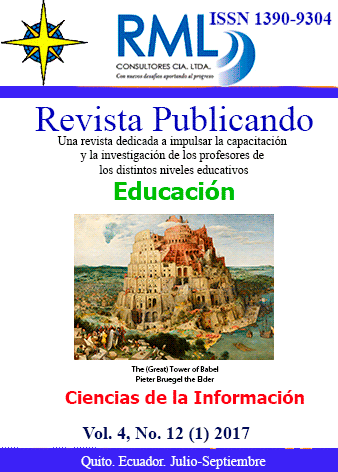Abstract
The Flipped classroom is a pedagogical methodology that modifies the natural order of teaching. This study analyzes this new trend to provide students with an innovative technique to support their learning of the English language grammar at the B1 + level. The traditional methodology is replaced by the use of technological resources to incorporate them in an effective way in the teaching practice with different instructions and materials. In this way we want to investigate if the use of the flipped classroom methodology influences the teaching of grammar in this level, for this we used the Edmodo platform where we put designs of presentations and attractive videos to the level B1 + of English Center of Languages of the Technical University of Ambato. For the investigation, a pre-test and a post-test were performed on a single control group. The evaluation was positive and significant because the results of the average post-test scores reflected a high improvement in academic performance.
References
Bergmann, J. &. (2014). Flipped learning: Maximizing face time. T+ D, 68(2), 28-31.
Bergmann, J. (2012). Flip your classroom: Reach every student in every class every day. Eugene, OR: International Society for Technology in Education.
Evseeva, A. &. (2015). Use of flipped classroom technology in language learning. Procedia-Social and Behavioral Sciences,, 206, 205-209.
Fulton, K. P. (2014). Time for learning: Top 10 reasons why flipping the classroom can change education. Corwin Press.
Moreno, L. B. (2016). Análisis de la implementación de Flipped Classroom en las asignaturas instrumentales de 4 º Educación Secundaria Obligatoria. Revista Electrónica de Tecnología Educativa,Edutec, 55.
Musallam, R. (2010). Musallam, R. (2010). The effects of screencasting as a multimedia pre-training tool to manage the intrinsic role of chemical equilibrium instruction for advance high school chemical studdents. doctoral dissertation. University of San francisco.
Overmyer, J. (. (2012). Flipped classrooms 101. Principal,, 46–47.
Pearson. (2013). Partners on Flipped Learning. . Electronic Education Report. Biblioteca digital ITESM: EBSCO Business Source Premier. , 5.
Raths, D. (2014). Nine video tips for a better flipped classroom. The Education Digest, 79(6),15.
Schmidt, S. M. (2016). The flipped classroom: a twist on teaching. Contemporary Issues in Education Research (Online), 9.
Tucker, B. (2012). The flipped classroom. Education next , 12.
You are free to:
Share — copy and redistribute the material in any medium or format.
Adapt — remix, transform, and build upon the material.
The licensor cannot revoke these freedoms as long as you follow the license terms.
Under the following terms:
Attribution — You must give appropriate credit, provide a link to the license, and indicate if changes were made. You may do so in any reasonable manner, but not in any way that suggests the licensor endorses you or your use.
NonCommercial — You may not use the material for commercial purposes.
ShareAlike — If you remix, transform, or build upon the material, you must distribute your contributions under the same license as the original.
No additional restrictions — You may not apply legal terms or technological measures that legally restrict others from doing anything the license permits.
